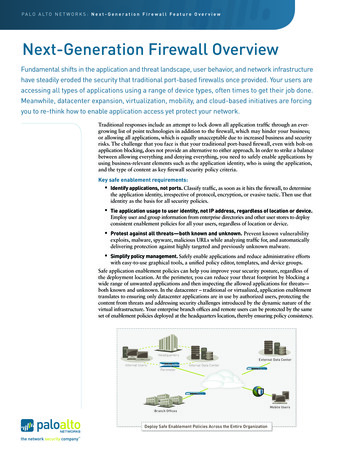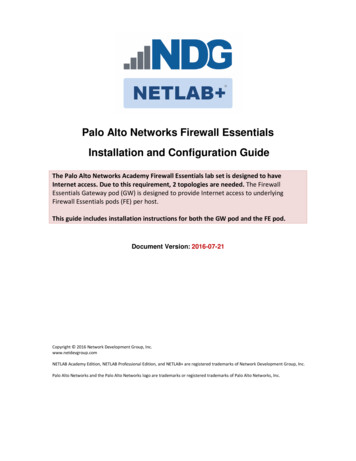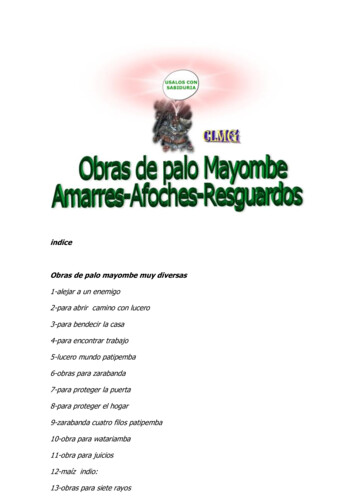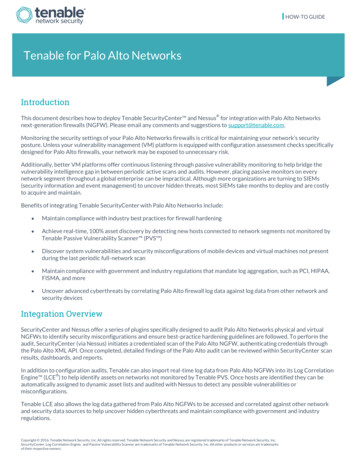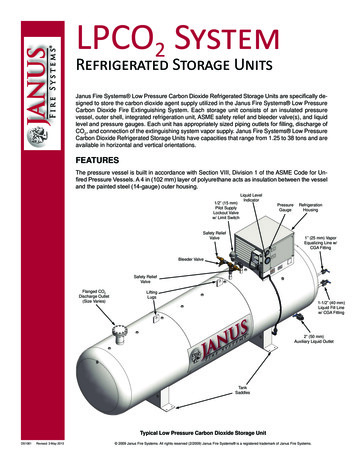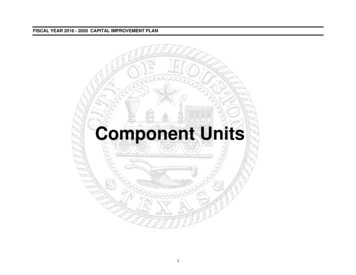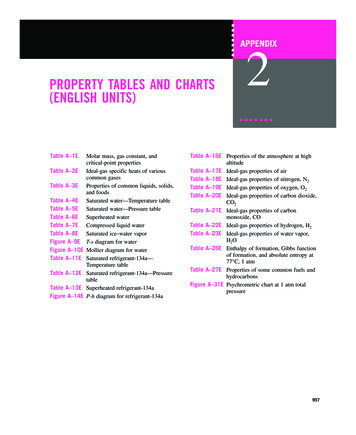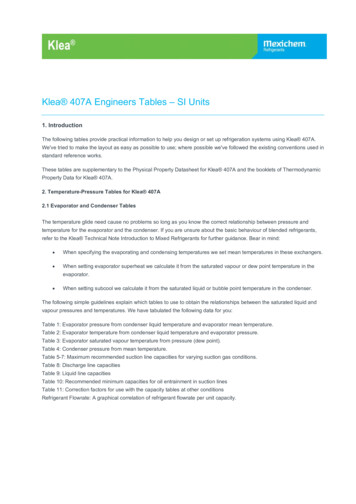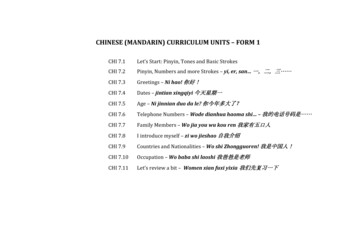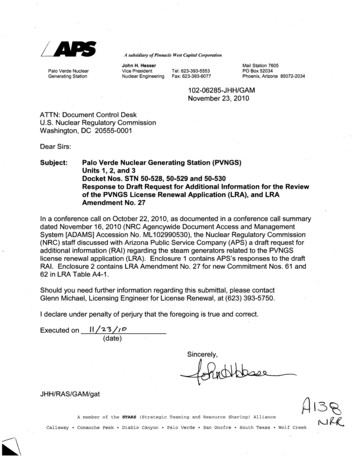
Transcription
AMIPA subsidiaryof Pinnacle West CapitalCorporationJohn H. HesserVice PresidentNuclear EngineeringPalo Verde NuclearGenerating StationTel: 623-393-5553Fax: 623-393-6077Mail Station 7605PO Box 52034Phoenix, Arizona 85072-2034102-06285-JHH/GAMNovember 23, 2010ATTN: Document Control DeskU.S. Nuclear Regulatory CommissionWashington, DC 20555-0001Dear Sirs:Subject:Palo Verde Nuclear Generating Station (PVNGS)Units 1, 2, and 3Docket Nos. STN 50-528, 50-529 and 50-530Response to Draft Request for Additional Information for the Reviewof the PVNGS License Renewal Application (LRA), and LRAAmendment No. 27In a conference call on October 22, 2010, as documented in a conference call summarydated November 16, 2010 (NRC Agencywide Document Access and ManagementSystem [ADAMS] Accession No. ML102990530), the Nuclear Regulatory Commission(NRC) staff discussed with Arizona Public Service Company (APS) a draft request foradditional information (RAI) regarding the steam generators related to the PVNGSlicense renewal application (LRA). Enclosure 1 contains APS's responses to the draftRAI. Enclosure 2 contains LRA Amendment No. 27 for new Commitment Nos. 61 and62 in LRA Table A4-1.Should you need further information regarding this submittal, please contactGlenn Michael, Licensing Engineer for License Renewal, at (623) 393-5750.I declare under penalty of perjury that the foregoing is true and correct.Executed on11/z3// 0(date)Sincerely,JHH/RAS/GAM/gatA member of the STARS (Strategic Teaming and Resource Sharing) AllianceCallaway Comanche Peak Diablo Canyon Palo Verde San Onofre South Texas Wolf Cre ek
ATTN: Document Control DeskU.S. Nuclear Regulatory CommissionResponse to Draft Request for Additional Information for the Review of the PVNGSLicense Renewal Application (LRA), and LRA Amendment No. 27Page 2Enclosures:cc:1.Response to Draft Request for Additional Information for the Review of thePVNGS License Renewal Application2.Palo Verde Nuclear Generating Station License Renewal ApplicationAmendment No. 27E. E. Collins Jr.J. R. HallL. K. GibsonJ. H, BashoreL. M. RegnerG. A. PickNRCNRCNRCNRCNRCNRCRegion IV Regional AdministratorNRR Senior Project ManagerNRR Project ManagerSenior Resident Inspector (acting) for PVNGSLicense Renewal Project ManagerRegion IV (electronic)
ENCLOSURE 1Response to Draft Request for Additional Information for theReview of the PVNGS License Renewal Application
Enclosure IResponse to Draft Request for Additional Informationfor the Review of the PVNGS License Renewal ApplicationNRC Draft RAI Regarding Steam Generators1. The Updated Final Safety Analysis Report (UFSAR), Section 1.2.3.3, states that avertical divider plate separates the inlet and outlet plenums in the lower head of thesteam generators (SGs), but no information about the materials of the divider plateassembly, nor its junction to the lower head and to the tubesheet was found in theUFSAR nor the LRA. Clarify how the divider plate is assembled to the lower headand to the tubesheet and what are the materials of this divider plate and potentialassociated welds. Ifthis information is in the UFSAR, please specify its location.(The NRC Staff provided the following request subsequent to the draft RAI above.)If the compositions of the SG divider plate divider bar welds (all areas) aresusceptible to primary water stress corrosion cracking (PWSCC), thereby potentiallycompromising SG reactor coolant system pressure boundary, provide an appropriateaging management program, including commitment, to manage for the possibleeffects of PWSCC on these welds. An inspection method must be capable ofdetecting PWSCC.2. Regarding LRA item 3.1.1-35, the applicant states that it's not applicable becausethey have recirculating SGs and the GALL Report item is for once-through SGs.However, this aging effect is applicable also for recirculating SGs tube-to-tubesheetwelds with tubesheet cladding of Alloy 600 and SG tubes of Alloy 690TT (which isthe case for Palo Verde). In such a configuration, the weld may have insufficientchromium content to prevent PWSCC. If the tubesheet cladding is Alloy 600,describe how PWSCC is managed for aging in the tube-to-tubesheet welds.3. LRA Table 3.1.2-4 does not include an item addressing GALL item IV.D1-17, whichcorresponds to ligament cracking due to corrosion in steel tube support plates.However, in LRA Table 3.1.2-4, the applicant addresses GALL item IV.D1-19, whichcorresponds to SG tube denting due to corrosion of carbon steel tube support plate.In LRA Section B2.1.8, the applicant also states that the tube support system issimilar to the original design, and like the original design is fabricated from 409ferritic stainless steel. Explain this apparent inconsistency.APS Response to Draft RAI Regarding Steam GeneratorsResponse (1)The steam generator (SG) primary side divider plates are attached to the channel head,stay cylinder, and tubesheet via a tongue-in-groove connection. The divider plateedges are grooved to slide onto the tongue portion of divider plate bars that are weldedto the channel head, stay cylinder, and tubesheet cladding. Set screws at the dividerplate groove to divider plate bar tongue connection are utilized to minimize movement ofthe floating divider plate. Small patch plates are installed at the two upper corners on1
Enclosure 1Response to Draft Request for Additional Informationfor the Review of the PVNGS License Renewal Applicationboth sides of each divider plate via a bolted connection. All screws and bolts arewelded over. All components (two divider plates, divider plate bars, patch plates, bolts,and screws) are manufactured from Alloy 690 material. The SG specifications show thedivider plate bars welded to the channel head, stay cylinder, and tubesheet claddingusing Alloy 52, 82, 152, and 182 filler materials. This level of detailed information is notincluded in the UFSAR.There is no routine inspection requirement for the divider bar welds because of thefollowing:*** These welds do not provide a reactor coolant system pressure boundary.These welds do not provide structural support to the SGs.The divider plate "floats" in the tongue and groove, and the force on the dividerplate that would get transferred to the divider plate bar welds would be therelatively low (compared with RCS pressure) differential pressure between theSG inlet (hot leg) and outlet (cold leg).A crack in the divider bar weld due to PWSCC would need to propagate from thedivider bar weld through the channel head cladding to get to the base metal.In response to the NRC staff concern regarding potential failure of the SG reactorcoolant system pressure boundary due to possible PWSCC of SG divider plate barwelds, APS commits to perform one of the following three resolution options:1. Perform an inspection of each Palo Verde Unit 1, 2, and 3 steam generator toassess the condition of the divider plate bar welds. The examinationtechnique(s) will be capable of detecting PWSCC in the divider plate bar welds.OR2. Perform an analytical evaluation of the steam generator divider plate bar welds inorder to establish a technical basis which concludes that the SG reactor coolantsystem pressure boundary is adequately maintained with the presence of steamgenerator divider plate bar weld cracking.OR3. If results of industry and NRC studies and operating experience document thatpotential failure of the SG reactor coolant system pressure boundary due toPWSCC cracking of SG divider plate bar welds is not a credible concern, thiscommitment will be revised to reflect that conclusion.The original SGs were replaced in Units 1, 2, and 3, during the fall of 2005, 2003, and2007, respectively. If Option (1) is selected, it will be completed for each SG in eachunit during an SG tube eddy-current inspection outage between 20 and 25 calendaryears of SG operation. For Units 1 and 3, this would approximately correspond to the2
Enclosure 1Response to Draft Request for Additional Informationfor the Review of the PVNGS License Renewal Applicationfirst five years after entering the period of extended operation (PEO). For Unit 2, thiswould approximately correspond to between three years prior to and two years afterentering the PEO.Unit 1, Option (1):Perform on each SG during an SG tube eddy-currentinspection outage between 9/1/25 and 12/1/30. (PEO wouldbegin 6/1/25.)Unit 2, Option (1):Perform on each SG during an SG tube eddy-currentinspection outage between 9/1/23 and 12/1/28. (PEO wouldbegin 4/24/26.)Unit 3, Option (1):Perform on each SG during an SG tube eddy-currentinspection outage between 9/1/27 and 12/1/32. (PEO wouldbegin 11/25/27.)If Option (2) or Option (3) is selected, it will be completed prior to September 1, 2023.Response (2)The tubes in the PVNGS SGs are manufactured from Alloy 690TT, and the tubesheetcladding is composed of Alloy 82. A review of industry operating experience has foundno instances of Alloy 82 primary water stress corrosion cracking (PWSCC) in theindustry when it is not used with Alloy 182. The tube-to-tubesheet weld is anautogenous weld, which is created by melting the corner of the tubesheet clad to thetube end without adding filler metal. The weld is thus a combination of both materials.Section 2.2 of EPRI Technical Report 1006696, Materials Reliability Program CrackGrowth Rates for Evaluating Primary Water Stress Corrosion Cracking (PWSCC) ofAlloy 82, 182, and 132 Welds (MRP-115), states that Alloy 82, which has a chromiumcontent of between 18-20%, took 3 to 4 times longer to crack than Alloy 182, which hasa chromium content of approximately 14.5%. For comparison purposes, the chromiumcontent of Alloy 600 is between 14-17%. The EPRI document also states that weldmetals with 30% chromium were resistant to cracking, with a threshold for PWSCCresistance being between 22 and 30% chromium. Since the chromium content of Alloy690TT is 30%, the tube-to-tubesheet weld in the PVNGS SGs would be expected tohave a chromium content somewhere between 20% and 30%.Alloy 82 weld metal, with its higher chromium content, has proven to be less susceptibleto PWSCC and to have lower crack growth rates than Alloy 182 weld metal. Since theearly 1990s, Palo Verde has used Alloy 82 for repairs on several Alloy 600 components(high temperature locations). Those repairs were on instrumentation nozzles on the hotleg and pressurizer, and pressurizer heater sleeves. The repairs consisted of halfnozzle replacements using Alloy 690 nozzles welded with Alloy 82. The nozzles andwelds are inspected visually every refueling outage and have had no leakage.3
Enclosure 1Response to Draft Request for Additional Informationfor the Review of the PVNGS License Renewal ApplicationIn response to the NRC staff concern regarding potential failure of the steam generatorprimary-to-secondary pressure boundary due to PWSCC cracking of tube-to-tubesheetwelds, APS commits to perform one of the following two resolution options:1. Perform a one-time inspection of a representative number of tube-to-tubesheetwelds in each steam generator to determine if PWSCC cracking is present. Ifweld cracking is identified:a. The condition will be resolved through repair or engineering evaluation to. justify continued service, as appropriate.ANDb. An ongoing monitoring program will be established to perform routine tube-totubesheet weld inspections for the remaining life of the steam generators.OR2. Perform an analytical evaluation of the steam generator tube-to-tubesheet weldsin order to:a. Establish a technical basis which concludes that the structural integrity of thesteam generator tube-to-tubesheet interface is adequately maintained withthe presence of tube-to-tubesheet weld cracking.ANDb. Establish a technical basis which concludes that the steam generator tube-totubesheet welds are not required to perform a reactor coolant pressureboundary function.If Option (1) is elected, it will be completed on the same schedule as Option (1)described in Response (1) above. If Option (2) is selected, it will be on the sameschedule as Option (2) described in Response (1) above.Response (3)GALL line IV.D1-19 for steam generator tube denting due to corrosion of carbon steelsupport plates was applied in error and was deleted in LRA Amendment 26 submittedwith APS letter no. 102-06279, dated November 10,/2010. The Palo Verde steamgenerator tube support system is fabricated with 409 ferritic stainless steel; therefore,the GALL line IV.D1-19 for denting due to corrosion of carbon steel support plates is notapplicable.4
ENCLOSURE 2Palo Verde Nuclear Generating StationLicense Renewal ApplicationAmendment No. 27LRA SectionTable A4-1, Item 61Table A4-1, Item 62Page No.A-60A-60I
Palo Verde Nuclear Generating StationLicense Renewal ApplicationAmendment No. 27LRA Table A4-1, License Renewal Commitment No. 61:ItemNO.'61CommimIn response to the NRC staff concern regarding potential failure of the SGreactor coolant system pressure boundary due to possible PWSCC of SG dividerplate bar welds, APS commits to perform one of the following three resolutionoptions:1. Perform an inspection of each Palo Verde Unit 1, 2, and 3 steamgenerator to assess the condition of the divider plate bar welds. Theexamination technique(s) will be capable of detecting PWSCC in thedivider plate bar welds.OR2. Perform an analytical evaluation of the steam generator divider plate barwelds in order to establish a technical basis which concludes that the SGreactor coolant system pressure boundary is adequately maintained withthe presence of steam generator divider plate bar weld cracking.OR3. If results of industry and NRC studies and operating experiencedocument that potential failure of the SG reactor coolant systempressure boundary due to PWSCC cracking of SG divider plate barwelds is not a credible concern, this commitment will be revised to reflectthat conclusion.(RCTSAIs 3561775 [Ul], 3561777 [U2], 3561779 [U3])LRA SectionResponse to Draft RAIRegarding SteamGenerators in APS letterNo. 102-06285, datedNovember 23, 2010.ImplementationSchedul elIf Option (1) is selected,it will be completed foreach SG in each unitduring an SG tubeeddy-current inspectionoutage between 20 and25 calendar years of SGoperation.If Option (2) or Option(3) is selected, it will becompleted prior toSeptember 1, 2023.
Enclosure 1Response to Draft Request for Additional Informationfor the Review of the PVNGS License Renewal ApplicationLRA Table A4-1, License Renewal Commitment No. 62:Iteml62.Commitment,In response to the NRC staff concern regarding potential failure of the steamgenerator primary-to-secondary pressure boundary due to PWSCC cracking oftube-to-tubesheet welds, APS commits to perform one of the following tworesolution options:1. Perform a one-time inspection of a representative number of tube-totubesheet welds in each steam generator to determine if PWSCCcracking is present. If weld cracking is identified:a. The condition will be resolved through repair or engineeringevaluation to justify continued service, as appropriate.ANDb. An ongoing monitoring program will be established to performroutine tube-to-tubesheet weld inspections for the remaining life ofthe steam generators.OR2. Perform an analytical evaluation of the steam generator tube-totubesheet welds in order to:a. Establish a technical basis which concludes that the structuralintegrity of the steam generator tube-to-tubesheet interface isadequately maintained with the presence of tube-to-tubesheet weldcracking.ANDb. Establish a technical basis which concludes that the steamgenerator tube-to-tubesheet welds are not required to perform areactor coolant pressure boundary function.(RCTSAIs 3561782 [U1-, 3561784 [U2], 3561788 [U3])LRA SectionResponse to Draft RAIRegarding SteamGenerators in APS letterNo. 102-06285, datedNovember 23, 2010.ImplementationIf Option (1) is selected,it will be completed foreach SG in each unitduring an SG tubeeddy-current inspectionoutage between 20 and25 calendar years of SGoperation.If Option (2) is selected,it will be completed priorto September 1, 2023.
AMIP A subsidiary of Pinnacle West Capital Corporation Palo Verde Nuclear Generating Station John H. Hesser Vice President Nuclear Engineering Tel: 623-393-5553 Fax: 623-393-6077 Mail Station 7605 PO Box 52034 Phoenix, Arizona 85072-2034 102-06285-JHH/GAM November 23, 2010 ATTN: Document Control
